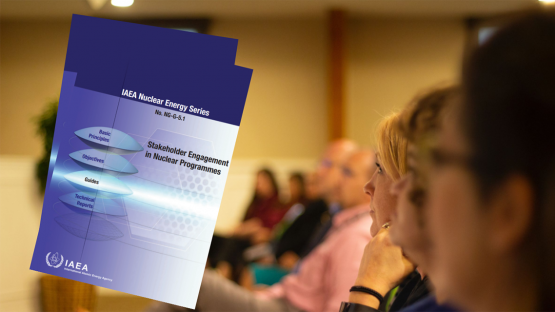To succeed, nuclear power and other nuclear projects need to engage with all relevant stakeholders, including the public. The IAEA has now released its first guide-level publication to support national efforts to engage with stakeholders throughout the life cycle of all nuclear facilities—from uranium mining and new and operating reactors to non-electric applications, radioactive waste management and decommissioning.
Stakeholder Engagement in Nuclear Programmes (Nuclear Energy Series No. NG-G-5.1) provides theoretical and practical guidance on developing and implementing stakeholder engagement programmes and activities. It is the latest in a series of IAEA initiatives to support countries in this area, including through the Agency’s Milestones Approach for countries introducing nuclear power, technical meetings, webinars and other publications.
Stakeholders come in a variety of shapes and sizes. Some, such as regulators, are required by law to be involved in projects. Others include any individuals or groups who feel affected by an activity. In order to enhance confidence in the project and build trust, organizations are encouraged to develop and implement a stakeholder engagement programme, which can enable those individuals and groups to be involved and understand the basis for decisions.
“This publication builds on years working directly with governments and organizations, identifying good practices and crafting methodologies and approaches for effective stakeholder engagement,” said Lisa Berthelot, Technical Officer of the publication. “There is no engagement recipe, in the end, because each context is different, but this guide lays out the foundations for what is a crucial element in any nuclear programme.”
Explaining nuclear energy, strengthening relationships and building trust with stakeholders is key to the successful implementation, operation and expansion of all nuclear facilities, including nuclear power plants. The new guide will assist communication experts, senior managers and other experts to establish and maintain a long-term stakeholder engagement strategy and activities for a nuclear programme. These experts work for key organizations involved in the nuclear project or facility, including government, owner/operator and regulator. Other employees who are involved in communication or engagement activities will also find the content of this guide useful and relevant to their work.
“The publication is an excellent, basic principle level document which will be used as a part of our internal familiarization and on-job-training programmes for new communication officers and for senior and midlevel managers,” said Jaana Isotalo, Senior Vice President (HR & Communication) at TVO, a Finnish nuclear power company. “It gives an overview of the key elements of open, successful and transparent stakeholder engagement, as key components for the sustainable use of nuclear power.”
The publication, developed with the help of funding from the U.S. Department of Energy through the IAEA Peaceful Uses Initiative, identifies five key principles for effective engagement: building trust, demonstrating accountability, exhibiting openness and transparency, practicing early and frequent consultation and communicating the benefits and risks of the nuclear technology.
After providing an overview of the topic, the new guide covers the development of stakeholder engagement strategies and plans, including practical information such as stakeholder mapping. It then discusses the roles and responsibilities of key nuclear organizations and how the types of approaches and activities selected differ. Finally, engagement approaches for the different life cycle stages are examined, showing how each stage requires its own strategic approach.
Last month, the IAEA organized two events on stakeholder engagement and public acceptance. The “19th INPRO Dialogue Forum on Enhancing Public Acceptance of Nuclear Energy through Institutional Innovations” and the webinar on “Engaging with Policy and Decision Makers: Knowledgeable and Interested Leaders” underscored how effective stakeholder engagement is needed to support nuclear energy in fulfilling its potential tohelp countries to mitigate climate change and achieve energy security and sustainable development.
Stakeholder engagement is of particular interest to newcomer countries seeking to introduce a new nuclear power programme and is one of the 19 nuclear infrastructure issues that make up the IAEA’s Milestones Approach, together with others such as nuclear safety and security, funding and financing and radioactive waste management. There are currently around 30 such newcomers, with Bangladesh and Türkiye already constructing their first nuclear power plants.
‘’The IAEA has provided newcomer countries with insightful capacity building support in stakeholder engagement for years,” said Arda D. Duran of the Turkish Ministry of Energy and Natural Resources. “This new publication is an addition to its valuable bibliography as the first ‘guide level’ document on the topic. With this publication, the IAEA will keep helping newcomer countries to improve our understanding and ability to effectively engage with stakeholders.’’





